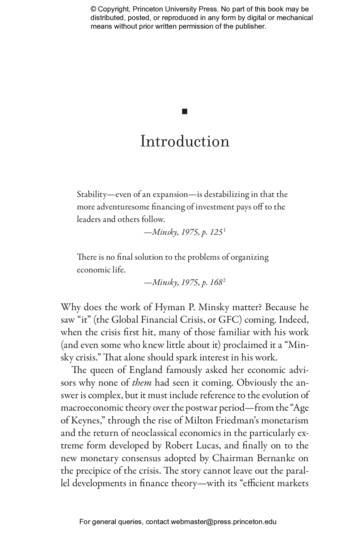
Transcription
Copyright, Princeton University Press. No part of this book may bedistributed, posted, or reproduced in any form by digital or mechanicalmeans without prior written permission of the publisher.IntroductionStability— even of an expansion— is destabilizing in that themore adventuresome financing of investment pays off to theleaders and others follow.—Minsky, 1975, p. 125 1There is no final solution to the problems of organizingeconomic life.—Minsky, 1975, p. 168 2Why does the work of Hyman P. Minsky matter? Because hesaw “it” (the Global Financial Crisis, or GFC) coming. Indeed,when the crisis first hit, many of those familiar with his work(and even some who knew little about it) proclaimed it a “Minsky crisis.” That alone should spark interest in his work.The queen of England famously asked her economic advisors why none of them had seen it coming. Obviously the answer is complex, but it must include reference to the evolution ofmacro economic theory over the postwar period— from the “Ageof Keynes,” through the rise of Milton Friedman’s monetarismand the return of neoclassical economics in the particularly extreme form developed by Robert Lucas, and finally on to thenew monetary consensus adopted by Chairman Bernanke onthe precipice of the crisis. The story cannot leave out the parallel developments in finance theory— with its “efficient marketsFor general queries, contact webmaster@press.princeton.edu
Copyright, Princeton University Press. No part of this book may bedistributed, posted, or reproduced in any form by digital or mechanicalmeans without prior written permission of the publisher.2 Introductionhypothesis”— and the “hands- off” approach to regulation andsupervision of financial institutions.What passed for macroeconomics on the verge of the globalfinancial collapse had little to do with reality. The world modeledby mainstream economics bore no relation to our economy. It wasbased on rational expectations in which everyone bets right, atleast within a random error, and maximizes anything and every thing while living in a world without financial institutions. Thereare no bubbles, no speculation, no crashes, and no crises in thesemodels. And everyone always pays all debts due on time.By contrast, Lake Wobegon appears to be impossibly unruly.No wonder mainstream economists never saw anything coming.In short, expecting the queen’s economists to foresee the crisis would be like putting flat- earthers in charge of navigationfor NASA and expecting them to accurately predict points ofreentry and landing of the space shuttle. The same can be saidof the U.S. president’s Council of Economic Advisers (CEA)— who actually had served as little more than cheerleaders for thetheory that so ill- served policy makers.This book provides an introduction to Minsky’s alternative approach to economic theory and policy and explains whyMinsky matters. Although there were a handful of economistswho had warned as early as 2000 about the possibility of a crisis, Minsky’s warnings actually began a half century earlier— with publications in 1957 that set out his vision of financialinstability. Over the next forty years, he refined and continuallyupdated the theory. It is not simply that he was more prescientthan others. His analysis digs much deeper. For that reason, hiswork can continue to guide us not only through the next crisis,but even those that will follow.Minsky’s view can be captured in his memorable phrase:“Stability is destabilizing.” What appears initially to be contradictory or perhaps ironic is actually tremendously insightful: toFor general queries, contact webmaster@press.princeton.edu
Copyright, Princeton University Press. No part of this book may bedistributed, posted, or reproduced in any form by digital or mechanicalmeans without prior written permission of the publisher.Introduction 3the degree that the economy achieves what looks to be robustand stable growth, this is setting up the conditions in which acrash becomes ever more likely. It is the stability that changesbehaviors, policy making, and business opportunities so thatthe instability results.Back in 1929, the most famous American economist, IrvingFisher, announced that the stock market had achieved a “permanent plateau,” having banished the possibility of a market crash.In the late 1960s, Keynesian economists such as Paul Samuelsonannounced that policy makers had learned how to “fine- tune”the economy so that neither inflation nor recession would everagain rear their ugly heads. In the mid- 1990s, Chairman Greenspan argued that the “new economy” reflected in the NASDAQequities boom had created conditions conducive to high growthwithout inflation. In 2004, Chairman Bernanke announcedthat the era of “the Great Moderation” had arrived so that recessions would be mild and financial fluctuations attenuated.In every case, there was ample evidence to support the belief that the economy and financial markets were more stable,that the “good times” would continue indefinitely, and thateconomists had finally gotten it right. In every case, the prognostications were completely wrong. In every case, the “stability is destabilizing” view had it right. In every case, Minsky wasvindicated.But Minsky left us with much more than a colorful and useful phrase.The Wall Street ParadigmMinsky had his feet firmly planted in two worlds. One wasthe world of “high theory”— the academic environment inwhich economists create theories and models and occasionallyFor general queries, contact webmaster@press.princeton.edu
Copyright, Princeton University Press. No part of this book may bedistributed, posted, or reproduced in any form by digital or mechanicalmeans without prior written permission of the publisher.4 Introductiontest them with economic data. Unfortunately, as mainstreammacro economic theory has so vividly demonstrated in recentyears, this can be about as useful as debating “angels on pinheads” when it comes to developing an understanding of theway the world actually works.However, Minsky had his other foot firmly planted out inthe real world of financial markets. Indeed, he always claimedthat he began from a “Wall Street paradigm.” To be clear, thatdid not mean that he was one of those “1 percenters” that Occupy Wall Street has been demonstrating against! What Minsky meant was that you’ve got to understand “high finance” inorder to understand our modern economy. And Minsky had adeep understanding of banks and other financial institutions aswell as of financial markets.This understanding helped Minsky to develop an alternative approach. He not only saw it coming, but all along the wayhe warned that “it” (another Great Depression) could happenagain.3 In retrospect, he had identified in “real time” those financial innovations that would eventually create the conditionsthat led to the GFC— such as securitization, rising debt ratios,layering debts on debts, and leveraged buyouts.Furthermore, from the beginning he had formulated policiesthat if applied would have attenuated the thrust toward instability. As the financial system evolved over that half centuryduring which Minsky developed his theories and policies, hecontinually updated his recommendations.Ironically, mainstream economics went in precisely the opposite direction: as the financial system became increasinglycomplex and dominant, orthodox thinking actually simplified its approach to finance and relegated Wall Street’s role toinsignificance in the models that came out of academic ivorytowers.As if that were not bad enough, the government officialsin charge of regulating and supervising these behemothsFor general queries, contact webmaster@press.princeton.edu
Copyright, Princeton University Press. No part of this book may bedistributed, posted, or reproduced in any form by digital or mechanicalmeans without prior written permission of the publisher.Introduction 5frequently adopted simplistic and ultimately dangerous mainstream beliefs.It Happened Again!Even the U.S. government’s own investigation of the causes ofthe GFC pointed a finger at the failure of our “public stewards”to constrain the runaway financial system. The Financial CrisisInquiry Report 4 makes a strong case that the crisis was foreseeable and avoidable. It did not “just happen,” and it had nothingto do with “black swans with fat tails.” It was created by the biggest banks under the noses of our regulators.According to the report, the GFC represents a dramatic failure of corporate governance and risk management, in large parta result of an unwarranted and unwise focus on trading (actually, gambling) and rapid growth (a good indication of fraud, asWilliam Black5 argues). Indeed, the biggest banks were aidedand abetted by government overseers who not only refused todo their jobs but also continually pushed for deregulation anddesupervision in favor of self- regulation and self- supervision.For example, President Clinton’s Secretary of the TreasuryLarry Summers— a nephew of Paul Samuelson and the mostprominent Harvard Keynesian of today— famously pushed forderegulation of “derivatives” that played a critical enabling rolein creating the financial tsunami that sank the economy.There is a danger in focusing on bad actors, bad financialpractices, and bad events.6 To be sure, it is a scandal that thosemost responsible for the crisis— top management at the biggestbanks and “shadow banks”— have not faced prosecution. Still, itis important to understand longer term trends. Minsky helps usto put the crisis in the context of the postwar transformation ofthe financial system, and he would agree that we should not pinall the blame on bad apples.For general queries, contact webmaster@press.princeton.edu
Copyright, Princeton University Press. No part of this book may bedistributed, posted, or reproduced in any form by digital or mechanicalmeans without prior written permission of the publisher.6 IntroductionLessons from the GFCAs Minsky would say, financial fragility had grown on trendfrom the 1960s to the latest crash, making “it” (another “GreatCrash” like that of the 1930s) likely to “happen again.” For thatreason, although the GFC was not strictly inevitable, the financial structure made a crisis highly probable. In many importantrespects, we had produced conditions similar to those that existed on the eve of the Great Depression— and we experienceda similar crisis.The most important difference, however, was the response.As Minsky would say, the “Big Bank” (the U.S. Federal ReserveBank, or Fed) and the “Big Government” (Uncle Sam’s Treasury) saved us from the worst— we did not fall into a depression. Yes, we had a terrible recession (that we still had not fullyescaped even six years later), and we had a monstrous collapse ofthe financial system that wiped out trillions of dollars of wealth.But though unemployment reached into the double digits— perhaps 25 million workers were without jobs— the social safetynet originally put in place during President Roosevelt’s NewDeal and President Johnson’s War on Poverty prevented the extent of suffering we saw in the 1930s.President Obama’s “Big Government” budget deficit grew toa trillion dollars (in part due to a hastily formulated stimuluspackage), which helped to prop up the economy.And Fed Chairman Benjamin Bernanke put together a “BigBank” rescue package of 29 trillion (yes, you read that correctly!) to save the world’s banking system.7 As a result, we sawvery few runs on banks and remarkably few bank failures giventhat this was by far the worst financial crisis since the GreatDepression (when President Roosevelt had to declare a bank“holiday” to stop runs, with only half of all the banks allowedto reopen).For general queries, contact webmaster@press.princeton.edu
Copyright, Princeton University Press. No part of this book may bedistributed, posted, or reproduced in any form by digital or mechanicalmeans without prior written permission of the publisher.Introduction 7As Minsky argued, the only sensible response to a financialcrisis is for the Fed to act as “lender of last resort” to preventwhat Irving Fisher called a “debt deflation” caused by fire salesof financial assets as panicked households, firms, and banks tryto liquidate their wealth.8 President Hoover’s Treasury Secretary at the start of the Great Depression, Andrew Mellon, hadinfamously recommended liquidation as a solution to the crisis:“liquidate labor, liquidate stocks, liquidate farmers, liquidatereal estate . . . it will purge the rottenness out of the system.”9But by selling everything, prices collapsed, bankrupting farmers, firms, and households— making the depression much worse.Although Chairman Bernanke’s response was clumsy, thereis little doubt that the Fed played the critical role in saving thebanks and preventing asset prices from a free fall.Still, the outcome was far from rosy. Whereas we emergedfrom the Great Depression with a robust financial system, strictregulation, and strong safety nets, as of 2015, we have onlymanaged to prop up the financial institutions that caused thecrisis— and have left the economy in a much weaker state than ithad been in either 2006 or 1940. Tens of millions of U.S. homeowners remain deeply underwater in their mortgages, and millions have already lost their homes.Although official unemployment rates came down, much ofthe improvement is illusory— millions of workers have given upall hope and left the labor force. Even after years of “recovery,”both the homeownership rate (percentage of Americans whoown their homes) and the employment rate (percentage of theadult population with jobs) are stuck well below where theywere before the GFC. Inequality has actually increased, and allof the gains in the recovery have gone to the very top of the income and wealth distribution.And because the federal government in Washington did notfollow Roosevelt’s example in undertaking a thorough reformFor general queries, contact webmaster@press.princeton.edu
Copyright, Princeton University Press. No part of this book may bedistributed, posted, or reproduced in any form by digital or mechanicalmeans without prior written permission of the publisher.8 Introductionof the financial system, our biggest banks are actually even bigger and more dangerous than they were on the eve of the GFC.They’ve resumed many of the same practices that created theGFC. Our public stewards are again allowing this to happen.We didn’t seem to learn much from the GFC.The Mainstream Discovers MinskyAs mentioned at the outset of this introduction, when the crisis hit, prominent economists discovered Minsky. The most famous U.S. Keynesian, Paul Krugman, even devoted a numberof his New York Times columns to Minsky’s work. In May 2009,Krugman announced to his readers that he was going to delveinto Minsky’s 1986 book:So I’m actually reading Hyman Minsky’s magnum opus10,here in Seoul . . . And I have to say that the Platonic ideal ofMinsky is a lot better than the reality. There’s a deep insightin there; both the concept of financial fragility and his insight, way ahead of anyone else, that as the memory of theDepression faded the system was in fact becoming morefragile. But that insight takes up part of Chapter 9. The restis a long slog through turgid writing, Kaleckian incomedistribution theory (which I don’t think has anything to dowith the fundamental point), and more. To be fair, it tookme several decades before I learned to appreciate Keynes inthe original. Maybe a reread will make me see the depths ofMinsky’s insight across the board. Or maybe not.11Krugman went on to give three lectures at the London Schoolof Economics (LSE), the third of which he titled “The NightThey Reread Minsky.” During his talk, he claimed “I was intoFor general queries, contact webmaster@press.princeton.edu
Copyright, Princeton University Press. No part of this book may bedistributed, posted, or reproduced in any form by digital or mechanicalmeans without prior written permission of the publisher.Introduction 9Minsky before Minsky was cool,” and he gave Minsky credit forrecognizing the growing fragility of the economy long before itfinally collapsed into the GFC.Similarly, speaking at the annual “Minsky Conference” inApril 2009,12 Janet Yellen (who would later replace ChairmanBernanke as the head of the Fed) commented:It’s a great pleasure to speak to this distinguished group at aconference named for Hyman P. Minsky. My last talk heretook place 13 years ago when I served on the Fed’s Boardof Governors. My topic then was “The ‘New’ Science ofCredit Risk Management at Financial Institutions.” It described innovations that I expected to improve the measurement and management of risk. My talk today is titled“A Minsky Meltdown: Lessons for Central B ankers.” Iwon’t dwell on the irony of that. Suffice it to say that, withthe financial world in turmoil, Minsky’s work has becomerequired reading. It is getting the recognition it richly deserves. The dramatic events of the past year and a half area classic case of the kind of systemic breakdown that he— and relatively few others— envisioned.13So if the foremost orthodox Keynesians “reread Minsky” andfound much to like, why hasn’t this led to a substantial reformof economic thinking and policy making?Minsky’s Rejection of the Presumption of StabilityIn his LSE lecture, Krugman explained that Minsky’s problemis that he rejected the mainstream’s orthodox, neoclassical economics in favor of a heterodox approach. That is why his ideasare not having the impact that they should.For general queries, contact webmaster@press.princeton.edu
Copyright, Princeton University Press. No part of this book may bedistributed, posted, or reproduced in any form by digital or mechanicalmeans without prior written permission of the publisher.10 IntroductionIn 2014 Krugman returned to that theme, arguing that inspite of its failure to “see it coming,” good old mainstream economics is able to explain the problem with 20– 20 hindsight:[T]he heterodox need to realize that they have, to an important extent, been working with the wrong story line.Here’s the story they tell themselves: the failure of economists to predict the global economic crisis (and the poorpolicy response thereto), plus the surge in inequality, showthe failure of conventional economic analysis. So it’s timeto dethrone the whole thing— basically, the whole edificedating back to Samuelson’s 1948 textbook— and give otherschools of thought equal time.Unfortunately for the heterodox (and arguably for theworld), this gets the story of what actually happened almost completely wrong.It is true that economists failed to predict the 2008 crisis(and so did almost everyone). But this wasn’t because economics lacked the tools to understand such things— we’velong had a pretty good understanding of the logic of banking crises. What happened instead was a failure of real- world observation— failure to notice the rising importanceof shadow banking. . . . This was a case of myopia— but itwasn’t a deep conceptual failure. And as soon as people didrecognize the importance of shadow banking, the wholething instantly fell into place: we were looking at a classicfinancial crisis.14According to Krugman, mainstreamers had simply failed to notice the rise of shadow banking— something Minsky had beentalking about at least since the early 1980s. Minsky had evenwritten an insightful piece on securitization in 1987, predicting“That which can be securitized will be securitized.”15For general queries, contact webmaster@press.princeton.edu
Copyright, Princeton University Press. No part of this book may bedistributed, posted, or reproduced in any form by digital or mechanicalmeans without prior written permission of the publisher.Introduction 11As this book makes clear, however, Krugman makes twofundamental errors. First, he does not understand banking. Bycontrast, Minsky had a deep understanding of bank operations,gained in part from his Wall Street connections and as wellfrom his experience sitting on the board of a St. Louis bank.That is a topic for chapter 4.More importantly, Krugman and other mainstream economists do not understand Minsky’s “beef” with orthodoxy. ForMinsky, the main problem is not that orthodoxy failed to “notice” the rise of shadow banks; he would argue that their theorycannot be made good by adding this detail to their analysis.Minsky’s critique was much more fundamental than that:mainstream economics begins with the presumption that theeconomy is naturally stable. Market forces are supposed to movethe economy back to “equilibrium”— where demand equals supply. This is precisely what Minsky rejected.The Economist’s Mea CulpaWith the benefit of hindsight, orthodox economists now recognize a number of factors that they claim to have led to the crisis.These are the things that Krugman and others wish they hadnoticed because then they would have seen the crisis coming.1. Black Swans with Fat Tails. In the euphoric boom of theearly 2000s, financial markets had priced the risks based onrelatively short time horizons— typically the previous fiveyears. They had also presumed that “tail risks” (the probability of something bad happening) were small. Note, however, that this was during the period proclaimed by Chairman Bernanke to be the “Era of the Great Moderation”— anunusually quiescent period in which asset prices marchedFor general queries, contact webmaster@press.princeton.edu
Copyright, Princeton University Press. No part of this book may bedistributed, posted, or reproduced in any form by digital or mechanicalmeans without prior written permission of the publisher.12 Introductionever- upward. That was particularly true of U.S. residentialreal estate— which was the main driver of the boom. Withhome prices rising steadily, defaults on mortgages and foreclosures were rare. Using this period to calculate risk ofdefault as well as to gauge tail risk would necessarily leadmarkets to massively underprice risk. They should have setaside bigger loss reserves in case a “black swan event” camealong so that they could cover the “fat tail” losses. We knowbetter now.2. The Fed Kept Interest Rates Too Low for Too Long. Coming out of the “Bush Recession” at the beginning of thetwenty- first century, the Fed kept rates low because therecovery was not creating enough jobs. With no inflationon the horizon, the Fed saw no reason to tighten monetarypolicy. But those low interest rates induced speculators toborrow to fuel asset price booms in real estate, commodities, and stocks. The Fed ignored “asset price inflation” as itfocused only on prices of the “real stuff ” consumers buy— which were rising slowly. If the Fed had been paying attention to the speculative bubble, it could have nipped it in thebud by raising rates. We know better now.3. No One Noticed the Rise of Shadow Banking (Krugman’spersonal favorite). Paul McCulley of PIMCO (which runsthe biggest bond mutual fund in the world) is credited withcoining the term “shadow bank” to refer to financial institutions that are not regulated and supervised as banks— things like pension funds, money market mutual funds,mortgage companies, and various kinds of securitizationvehicles. Over the two decades leading up to the GFC,these grew to be much larger than the commercial banksin terms of assets. They do many of the things banks do— including offering deposits and making loans— but without much government oversight. Most importantly, theyFor general queries, contact webmaster@press.princeton.edu
Copyright, Princeton University Press. No part of this book may bedistributed, posted, or reproduced in any form by digital or mechanicalmeans without prior written permission of the publisher.Introduction 13operate with much higher leverage ratios (the ratio of assets to capital or net worth). With very little of their “ownmoney” at risk, they mostly use “other people’s money” tobuy assets. Even a very small decline in the value of the assets they hold can wipe out all the capital, at which pointthe “other people” start losing. Our regulators should haveforced them to hold more capital, putting more of their“own money” at risk. We know better now.So, there was nothing wrong with the orthodox economics.We just need to put fat tail risk, asset price bubbles, and shadowbanks into the conventional models. Then we’ll see the next crisis coming. Or so the orthodox economists assure us!The policy response since the GFC has largely been basedon that view. The main recommendation is to adopt “macroprudential regulation” to reduce “systemic risk.” This is a hugetopic, and there is plenty of disagreement over what it reallymeans. However, the most important proposals have been toincrease capital requirements, to force financial institutions tohave “skin in the game” (more of their own money at risk), andto return some segmentation to the financial system. The idea isthat we want to have a segment of the system that is relativelysafe, where most people obtain their financial services, and keepthat mostly separate from a segment that takes greater risks forthose willing and able to bear them.Minsky’s Alternative VisionEven if we took the three factors listed above as contributingcauses to the GFC (which we should not do, as all three arguments are confused),16 Minsky would argue that addingthese to mainstream economics would do little good. It is theFor general queries, contact webmaster@press.princeton.edu
Copyright, Princeton University Press. No part of this book may bedistributed, posted, or reproduced in any form by digital or mechanicalmeans without prior written permission of the publisher.14 Introductionmainstream vision that is wrong— the belief that market forcesare fundamentally stabilizing.Most people have heard of Adam Smith’s metaphor of theinvisible hand.17 The idea is that a market economy in whichevery individual seeks to satisfy her own desires will naturallyreach the best possible outcome. More technically, those individuals are supposed to react to “price signals,” which will bringabout equality between demand and supply at a market- clearingequilibrium price.For example, if the demand for engineers exceeds supply,their salaries rise and induce more college students to choosethat profession. An equilibrium salary is reached, where demand equals supply. Similarly, if the supply of widgets exceedsthe demand, producers cut back on production and lower pricesuntil demand equals supply at the equilibrium price.That seems like common sense; the “trick” was to show thatthe market economy can reach an equilibrium where every market is simultaneously in equilibrium— a “general equilibrium”— with supplies equal to demands throughout the entire economy.Not only that, but it had to be shown that the general equilibrium is “stable,” meaning that the invisible hand of market forceswould invariably nudge the economy toward equilibrium if itever got out of equilibrium.The neoclassical “vision” is that Smith’s metaphor appliesto our real world. To be sure, no neoclassical economist arguesthat the real- world economy is always in equilibrium (althougha lot of their models do start from that presumption). Theybelieve that our economy is subject to “shocks”— one of thoseblack swan fat tail events— that move it away from equilibrium.However, the market forces operate to move the economy backto equilibrium after such shocks.There is a debate within the mainstream over just how fastthe market forces operate in the real world. Krugman hasFor general queries, contact webmaster@press.princeton.edu
Copyright, Princeton University Press. No part of this book may bedistributed, posted, or reproduced in any form by digital or mechanicalmeans without prior written permission of the publisher.Introduction 15made a famous distinction between “saltwater” (U.S. east coasteconomists at Harvard, Yale, and Princeton) and “freshwater”(University of Chicago) economists. The former believe thatthere are stubborn “frictions” that forestall the return to equilibrium, whereas the latter believe that the equilibrating forcesare strong. As a result, saltwater economists advocate a greaterrole for government to remove or counteract such frictions;freshwater economists think that government policy would beimpotent or even make matters worse.By contrast, Minsky argued that the internal dynamics ofour modern economy are not equilibrium- seeking. There’s noinvisible hand operating that way. Furthermore, if we ever didachieve the mainstream’s beloved “equilibrium,” those internaldynamics would push us away— the system is not stable. And ifby some miracle we were to get twice lucky— achieving an equilibrium that was stable— stability is destabilizing.This is because quiescence changes behavior, policy making,and business opportunities. Chairman Bernanke’s “Great Moderation” could not have been a stable equilibrium because marketparticipants took into account the “moderation,” discountingthe likelihood of black swans and fat tails. They took on morerisk. A stable economy also makes it ever more difficult to findprofitable opportunities as markets tend to become saturated.Finally, economic stability promotes fiscal tightening (throughautomatic stabilizers that increase tax revenue and lower somekinds of spending) and monetary policy tightening; it also promotes financial deregulation on the argument that the systemis more stable. These policy tendencies promote risk- taking. Allof these elements ensured that the system would move from arobust structure to a fragile financial profile.That is the fundamental insight that Minsky left with us. Andit is the insight that is rejected by freshwater and saltwater economists alike. They desperately want to keep their equilibriumFor general queries, contact webmaster@press.princeton.edu
Copyright
Back in 1929, the most famous American economist, Irving Fisher, announced that the stock market had achieved a “perma - nent plateau,” having banished the possibility of a market crash. In the late 1960s, Keynesian economists such as Paul Samuelson an
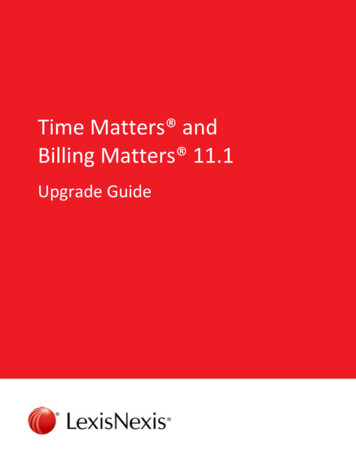
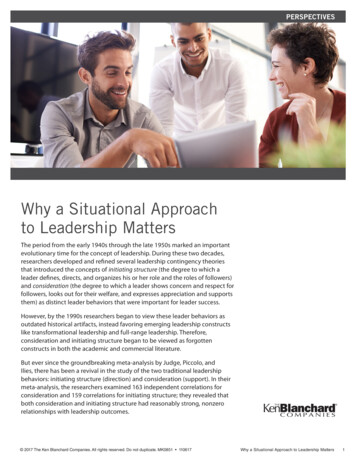
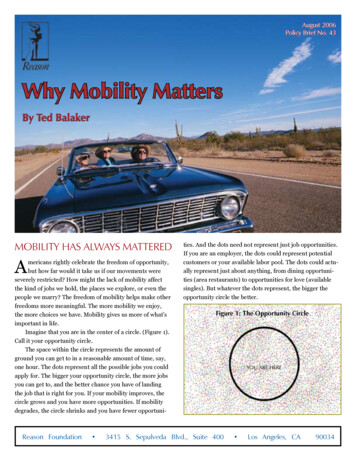
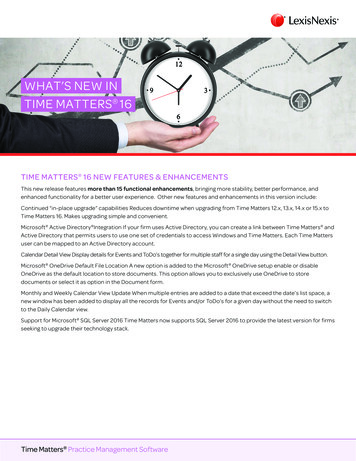



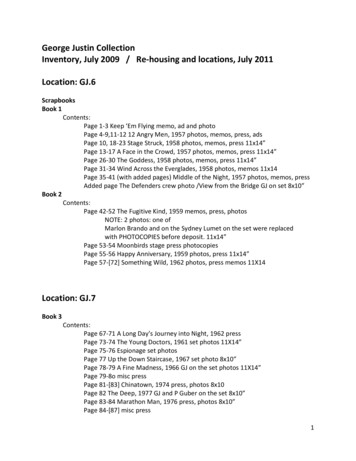
![[Page 1 – front cover] [Show cover CLEAN GET- AWAY 978-1 .](/img/13/9781984892973-6648.jpg)

